A 230-Year Summer Precipitation Variations Recorded by Tree-Ring δ18O in Heng Mountains, North China
Abstract
1. Introduction
2. Materials and Methods
2.1. Study Area, Sample Acquisition, and Pretreatment
2.2. α-Cellulose Extraction and Oxygen Isotope Measurement
2.3. Meteorological Stations Data
3. Results
3.1. Tree Ring δ18O Chronology
3.2. Climatic Response of the δ18Otree Chronology
3.3. The Establishment of the Transfer Function, Model Calibration and Verification
(N = 57, R = −0.671, R2 = 0.450, R2adj = 0.440, F = 44.981, P < 0.0001, D/W =1.582),
3.4. Characteristics and Spatial Representation of the Reconstructed PJ-J in 1784–2013 AD
3.5. Periodic Analysis and Ensemble Empirical Modal Decomposition of the Reconstruction
3.6. Large-Scale Climate Signals Reflected in the Reconstructed Precipitation Series
Relationship between Reconstructed Precipitation and the Asian Summer Monsoon (ASM)
3.7. Teleconnection with Remote Oceans
4. Discussion
4.1. Amount Effect Reflected in δ18Otree Levels at Heng Mountain
4.2. Large-Scale Circulations Affecting Precipitation in Heng Mountain
5. Conclusions
Supplementary Materials
Author Contributions
Funding
Conflicts of Interest
References
- Loader, N.J.; Robertson, I.; Barker, A.C.; Switsur, V.R.; Waterhouse, J.S. An improved technique for the batch processing of small wholewood samples to α-cellulose. Chem. Geol. 1997, 136, 313–317. [Google Scholar] [CrossRef]
- Brendel, O.; Iannetta, P.P.M.; Stewart, D. A rapid and simple method to isolate pure alpha-cellulose. Phytochem. Anal. 2000, 11, 7–10. [Google Scholar] [CrossRef]
- Mccarroll, D.; Loader, N.J. Stable isotopes in tree rings. Quat. Sci. Rev. 2004, 23, 771–801. [Google Scholar] [CrossRef]
- Dansgaard, W. Stable isotopes in precipitation. Tellus 1964, 16, 436–468. [Google Scholar] [CrossRef]
- Liu, Y.; Liu, H.; Song, H.M.; Li, Q.; Burr, G.S.; Wang, L.; Hu, S.L. A monsoon-related 174-year relative humidity record from tree-ring δ18O in the Yaoshan region, eastern central China. Sci. Total Environ. 2017, 593, 523–534. [Google Scholar] [CrossRef]
- Liu, Y.; Song, H.M.; Sun, C.F.; Song, Y.; Cai, Q.F.; Liu, R.S.; Lei, Y.; Li, Q. The 600-mm precipitation isoline distinguishes tree-ring width responses to climate in China. Natl. Sci. Rev. 2019, 6, 359–368. [Google Scholar] [CrossRef]
- Li, Q.; Liu, Y.; Nakatsuka, T.; Liu, R.S.; Cai, Q.F.; Song, H.M.; Wang, S.J.; Sun, C.F.; Fang, C.X. Delayed warming in Northeast China: Insights from an annual temperature reconstruction based on tree-ring δ18O. Sci. Total Environ. 2020, 749, 141432. [Google Scholar] [CrossRef]
- Sano, M.; Tshering, P.; Komori, J.; Fujita, K.; Xu, C.; Nakatsuka, T. May–September precipitation in the Bhutan Himalaya since 1743 as reconstructed from tree ring cellulose δ18O. J. Geophys. Res.-Atmos. 2013, 118, 8399–8410. [Google Scholar] [CrossRef]
- Xu, G.B.; Liu, X.H.; Qin, D.H.; Chen, T.; Wang, W.Z.; Wu, G.J.; Sun, W.Z.; An, W.L.; Zeng, X.M. Tree-ring δ18O evidence for the drought history of eastern Tianshan Mountains, northwest China since 1700 AD. Int. J. Climatol. 2015, 34, 3336–3347. [Google Scholar] [CrossRef]
- Liu, Y.; Wang, R.Y.; Leavitt, S.W.; Song, H.M.; Linderholm, H.W.; Li, Q.; An, Z.S. Individual and pooled tree-ring stable-carbon isotope series in Chinese pine from the Nan Wutai region, China: Common signal and climate relationships. Chem. Geol. 2012, 330, 17–26. [Google Scholar] [CrossRef]
- Liu, Y.; Cai, W.J.; Sun, C.F.; Song, H.M.; Cobb, K.M.; Li, J.P.; Leavitt, S.W.; Wu, L.X.; Cai, Q.F.; Liu, R.S.; et al. Anthropogenic aerosols cause recent pronounced weankening of Asian summer monsoon relative to last four centuries. Geophys. Res. Lett. 2019, 46, 5469–5479. [Google Scholar] [CrossRef]
- Cai, Q.; Liu, Y.; Tian, H. A dendroclimatic reconstruction of May–June mean temperature variation in the Heng Mounatins, north China, since 1767 AD. Quatern Int. 2013, 283, 3–10. [Google Scholar] [CrossRef]
- Sun, J.; Liu, Y. Responses of tree-ring growth and crop yield to drought indices in the Shanxi province, North China. Int. J. Biometeorol. 2013, 58, 1521–1530. [Google Scholar] [CrossRef]
- Li, Q.; Nakatsuka, T.; Kawamura, K.; Liu, Y.; Song, H.M. Hydroclimate variability in the North China Plain and its link with El Nino-Southern Oscillation since 1784 AD: Insights from tree-ring cellulose δ18O. J. Geophys. Res.-Atmos. 2011, 116, D22. [Google Scholar] [CrossRef]
- Li, Q.; Liu, Y.; Nakatsuka, T.; Song, H.M.; Mccarroll, D.; Yang, Y.K.; Qi, J. The 225-year precipitation variability inferred from tree-ring records in Shanxi Province, the North China, and its teleconnection with Indian summer monsoon. Glob. Planet Change 2015, 132, 11–19. [Google Scholar] [CrossRef]
- Speer, J.H. Fundamentals of Tree-Ring Research; The University of Arizona Press: Tucson, AZ, USA, 2010. [Google Scholar]
- Whistler, R.L.; Wolfrom, M.L.; Bemiller, J.N.; Shaw, D.H. (Eds.) Methods in Carbohydrate Chemistry; Academic Press: New York, NY, USA, 1964. [Google Scholar]
- Sharp, Z.D.; Atudorei, V.; Durakiewicz, T. A rapid method for determination of hydrogen and oxygen isotope ratios from water and hydrous minerals. Chem. Geol. 2001, 178, 197–210. [Google Scholar] [CrossRef]
- Fritts, H.C. Tree Rings and Climate: Calibration; Academic Press: New York, NJ, USA, 1976. [Google Scholar]
- Wigley, T.M.L.; Briffa, K.; Jones, G.P.D. On the average value of correlated time series, with applications in dendroclimatology and hydrometeorology. J. Appl. Meteorol. Clim. 1984, 23, 201–213. [Google Scholar] [CrossRef]
- Cook, E.R.; Meko, D.M.; Stahle, D.W.; Cleaveland, M.K. Drought reconstructions for the continental United States. J. Clim. 1999, 12, 1145–1162. [Google Scholar] [CrossRef]
- Liu, Y.; Cai, Q.F.; Shi, J.F.; Hughes, M.K.; Kutzbach, J.E.; Liu, Z.Y.; Ni, F.B.; An, Z.S. Seasonal precipitation in the south-central Helan Mountain region, China, reconstructed from tree-ring width for the past 224 years. Can. J. For. Res. 2005, 35, 2403–2412. [Google Scholar] [CrossRef]
- Li, Q.; Liu, Y.; Cai, Q.F.; Sun, J.Y.; Yi, L.; Song, H.M.; Wang, L. Reconstruction of annual precipitation since 1686 AD from Ningwu region, Shanxi province. Quat. Sci. 2006, 26, 999–1006. (In Chinese) [Google Scholar]
- Su, K.; Bai, H.Y.; Zhang, Y.; Huang, X.Y.; Qin, J. Reconstruction of precipitation history in Taibai Mountain of Qinling Mountains based on tree-ring width and meteorological data in recent 160 years. Chin. J. Ecol. 2018, 37, 1467–1475. (In Chinese) [Google Scholar]
- Wen, K.; Ding, Y. China Meteorological Disaster Compilation Committee; Meteorological Press: Beijing, China, 2006. (In Chinese) [Google Scholar]
- Shen, C.; Wang, W.C.; Hao, Z.; Gong, W. Characteristics of anomalous precipitation events over eastern China during the past five centuries. Clim. Dynam. 2008, 31, 463–476. [Google Scholar] [CrossRef]
- Liang, E.Y.; Liu, X.H.; Yuan, Y.J.; Qin, N.S.; Fang, X.Q.; Huang, L.; Zhu, H.F.; Wang, L.; Shao, X.M. The 1920s Drought Recorded by Tree Rings and Historical Documents in the Semi-Arid and Arid Areas of Northern China. Clim. Change 2006, 79, 403–432. [Google Scholar] [CrossRef]
- Dong, A.X.; Liu, Y.P.; Li, X.P.; Bai, H.Z. Characteristics and Influence of the Extreme Drought Event Lasting Eleven Years (1922–1932) in the Yellow River Valley. J. Arid. Meteorol. 2010, 28, 270–278. (In Chinese) [Google Scholar]
- Li, Y.J.; Gou, X.H.; Fang, K.Y.; Yang, T.; Deng, Y.; Man, Z.H. Reconstruction of precipitation of previous August to current June during 1821–2008 in the Eastern Qilian Mountains. J. Desert Res. 2012, 32, 1393–1401. (In Chinese) [Google Scholar]
- Mann, M.E.; Lees, J.M. Robust estimation of background noise and signal detection in climatic time series. Clim. Change 1996, 33, 409–445. [Google Scholar] [CrossRef]
- Miller, A.J.; Angell, J.K.; Korshove, J. Quasi-Biennial Oscillations in Tropospheric Energy. Mon. Weather. Rev. 1974, 102, 390–393. [Google Scholar] [CrossRef]
- Lau, K.M.; Kim, K.M.; Yang, S. Dynamical and Boundary Forcing Characteristics of Regional Components of the Asian Summer Monsoon. J. Clim. 2000, 13, 2461–2482. [Google Scholar] [CrossRef]
- Webster, P.J.; Yang, S. Monsoon and ENSO: Selectively interactive system. Q. J. R. Meteor. Soc. 2010, 118, 877–926. [Google Scholar] [CrossRef]
- Wang, B.; Wu, Z.; Li, J.; Jian, L.; Wu, G. How to Measure the Strength of the East Asian Summer Monsoon. J. Clim. 2008, 21, 4449–4463. [Google Scholar] [CrossRef]
- Zhu, C.W.; He, J.H.; Wu, G.X. East Asian monsoon index and its inter-annual relationship with largesca-le thermal dynamic circulation. Acta Meteorol. Sin. 2000, 58, 391–402. (In Chinese) [Google Scholar]
- Liu, Y.; Wang, L.; Li, Q.; Cai, Q.F.; Song, H.M.; Sun, C.F.; Liu, R.S.; Mei, R.C. Asian summer monsoon-related relative humidity record by tree-ring δ18O during last 205 years. J. Geophys. Res. Atmos. 2019, 124, 17–18. [Google Scholar] [CrossRef]
- Zhang, Q.Y.; Tao, S.Y.; Chen, L.T. The interannual variability of East Asian summer monsoon indices and its association with the pattern of general circulation over East Asia. Acta Meteorol. Sin. 2003, 61, 559–568. [Google Scholar]
- Xie, S.P.; Du, Y.; Huang, G.; Zheng, X.T.; Tokinaga, H.; Hu, K.M.; Liu, Q.Y. Decadal shift in el nino influences on indo-western pacific and east asian climate in the1970s. J. Clim. 2010, 23, 3352–3368. [Google Scholar] [CrossRef]
- Rozanski, K.; Luis, A.A.; Gonfiantini, R. Isotopic Patterns in Modern Global Precipitation[M]// Climate Change in Continental Isotopic Records; American Geophysical Union (AGU): Washington, DC, USA, 2013. [Google Scholar]
- Yamanaka, T.; Tsujimura, M.; Oyunbaatar, D.; Davaa, G. Isotopic variation of precipitation over eastern Mongolia and its implication for the atmospheric water cycle. J. Hydrol. 2007, 333, 21–34. [Google Scholar] [CrossRef]
- Torrence, C.; Webster, P.J. Interdecadal changes in the ENSO-monsoon system. J. Clim. 1999, 12, 2679–2690. [Google Scholar] [CrossRef]
- Liu, X.H.; An, W.L.; Treydte, K.; Shao, X.M.; Leavitt, S.; Hou, S.G.; Chen, T.; Sun, W.Z.; Qin, D.H. Tree-ring δ18O in southwestern China linked to variations in regional cloud cover and tropical sea surface temperature. Chem. Geol. 2012, 291, 104–115. [Google Scholar] [CrossRef]
- Xu, C.; Pumijumnong, N.; Nakatsuka, T.; Sano, M.; Guo, Z. Inter-annual and multi-decadal variability of monsoon season rainfall in central Thailand during the period 1804–1999, as inferred from tree ring oxygen isotopes. Int. J. Climatol. 2018, 38, 5766–5776. [Google Scholar] [CrossRef]
- Yu, M.; Jin, H. Influence of The Pacific Interdecadal Oscillation on summer Precipitation in the eastern Monsoon Region of China. Heilongjiang Meteorol. 2015, 32, 18–20. (In Chinese) [Google Scholar]
- Feng, S.; Hu, Q. How the North Atlantic Multidecadal Oscillation may have influenced the Indian summer monsoon during the past two millenia. Geophys. Res. Lett. 2008, 35, 548–562. [Google Scholar] [CrossRef]
- Yang, Q.; Ma, Z.; Xu, B. Modulation of monthly precipitation patterns over East China by the Pacific Decadal Oscillation. Clim. Change 2017, 144, 1–13. [Google Scholar] [CrossRef]


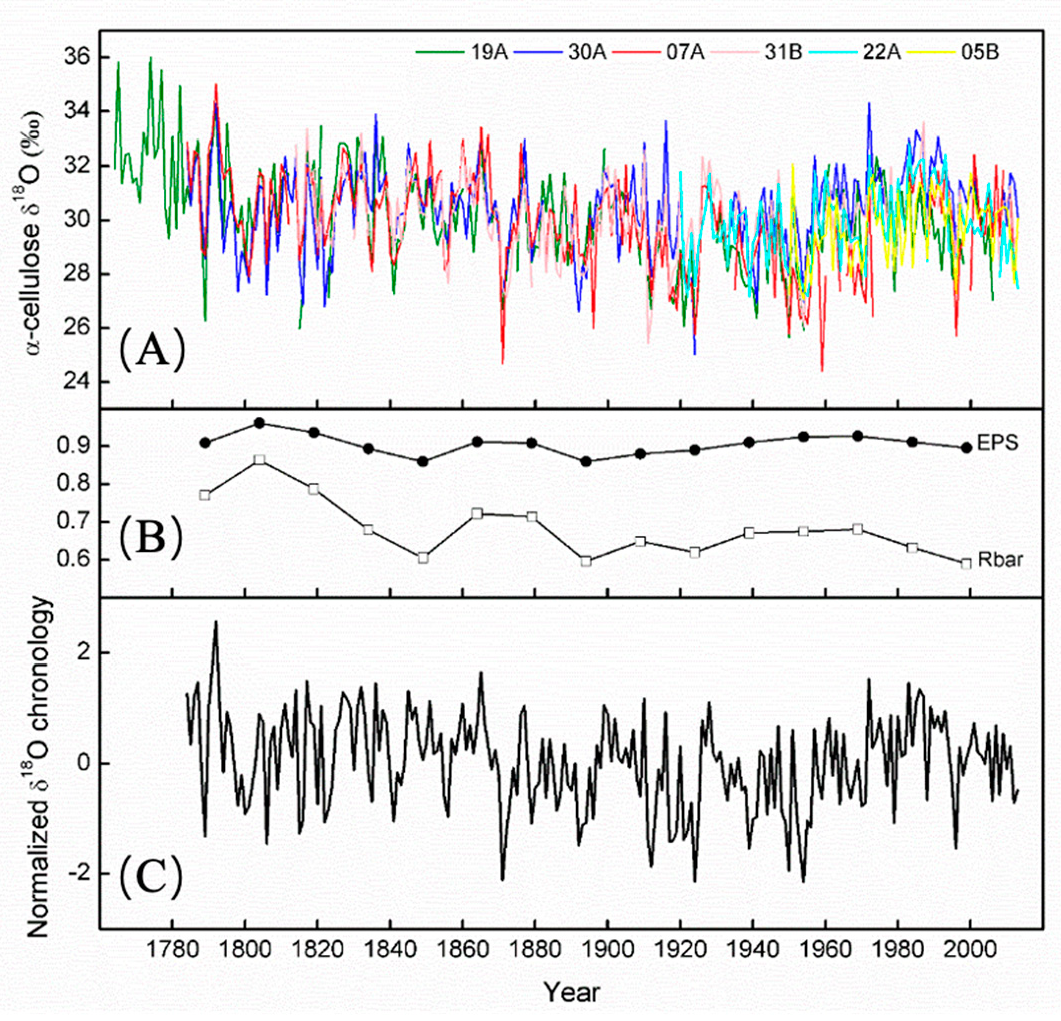
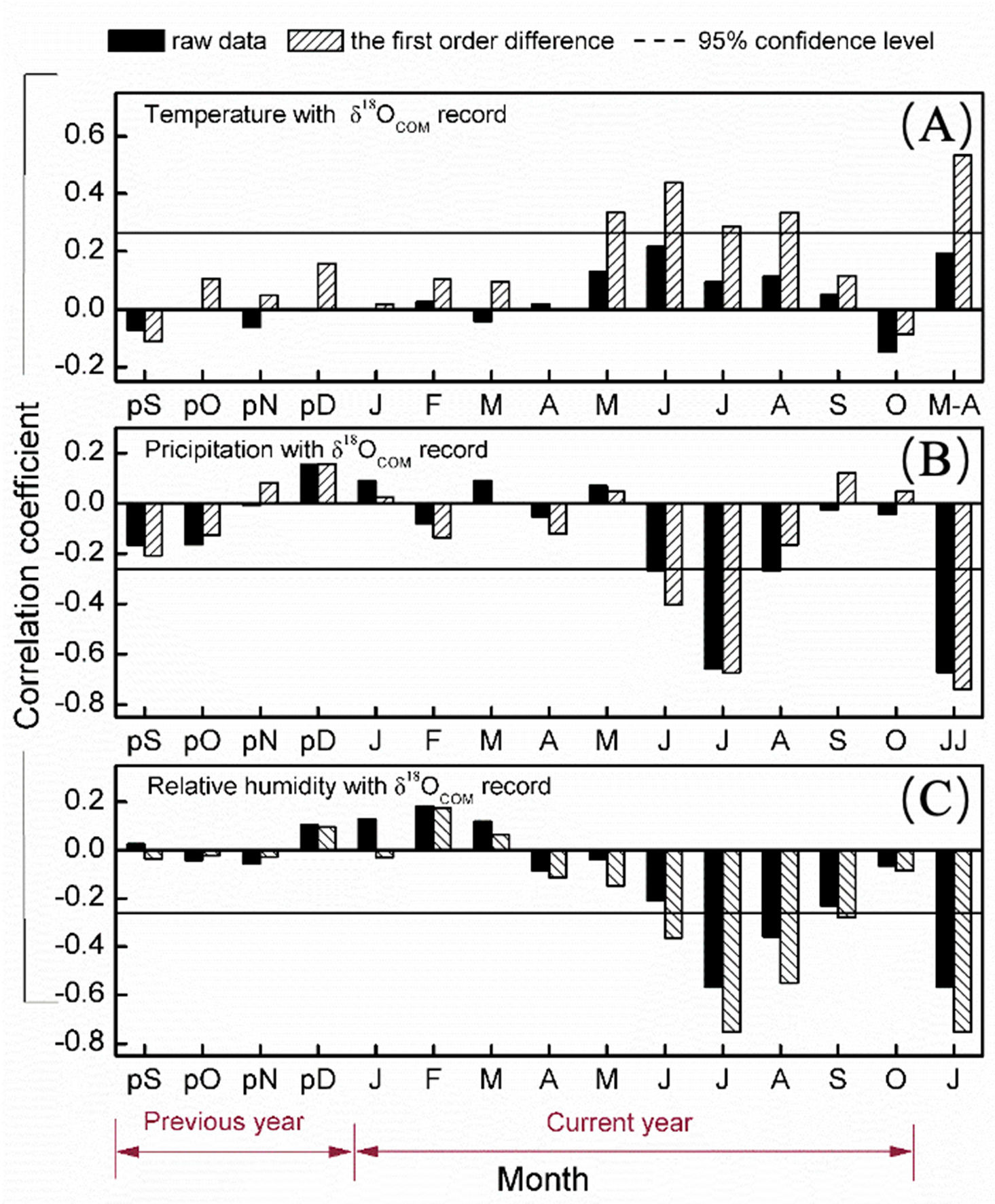
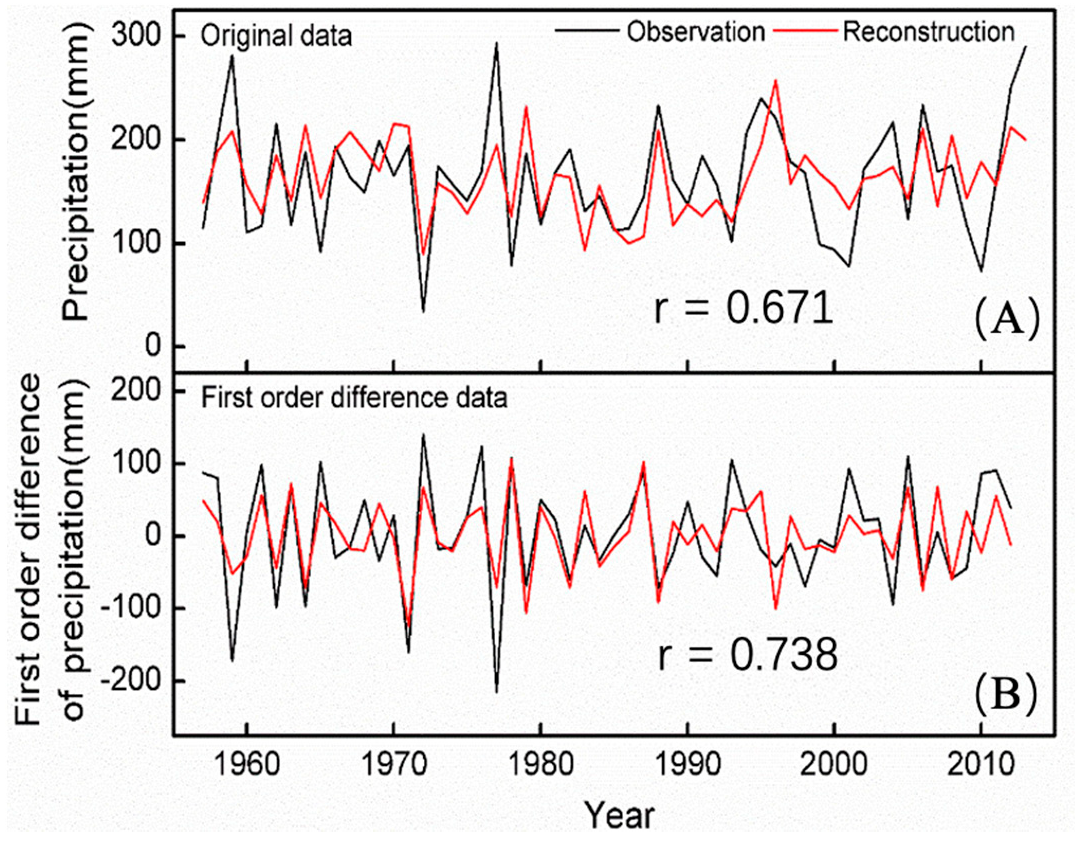

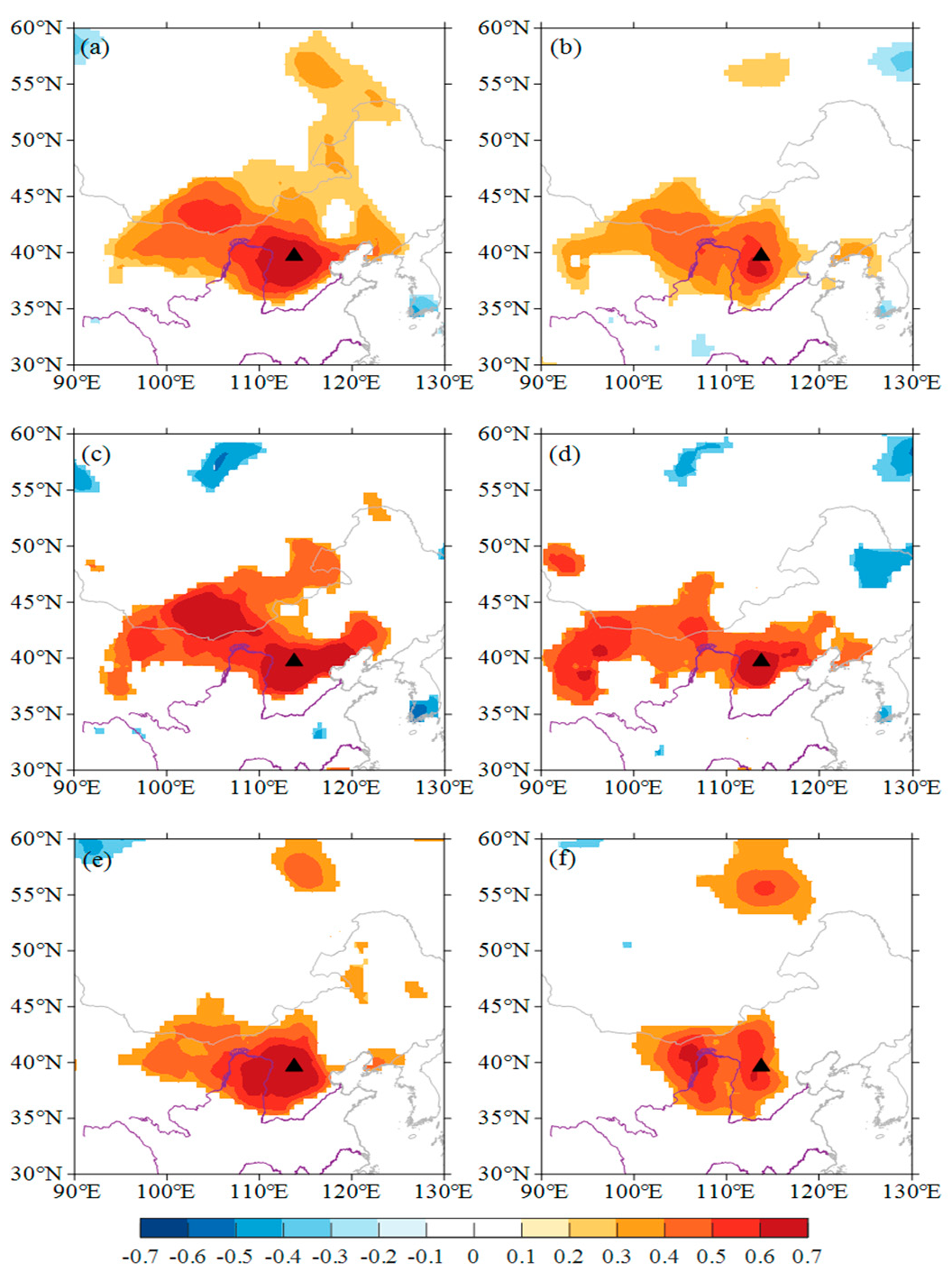
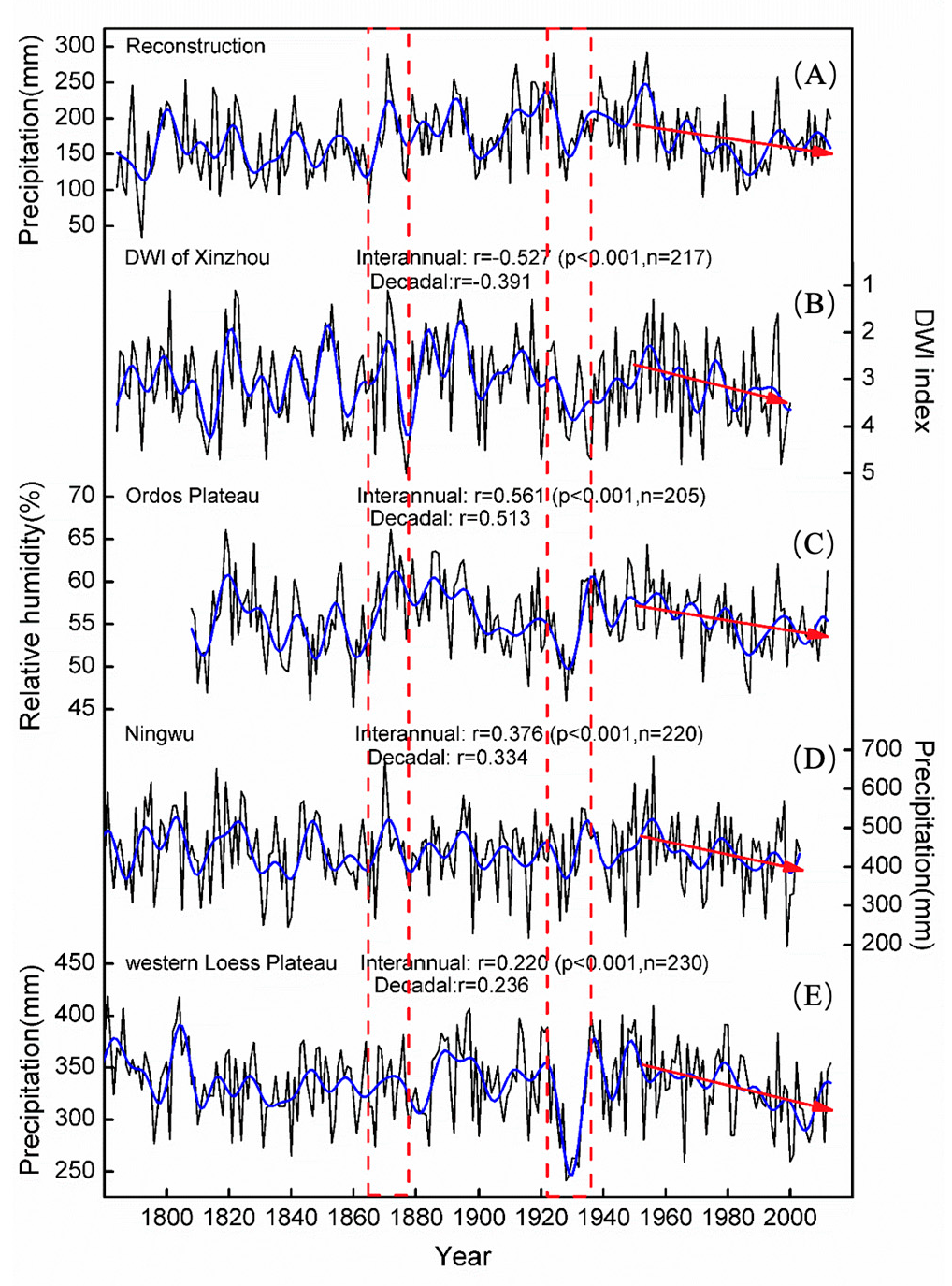
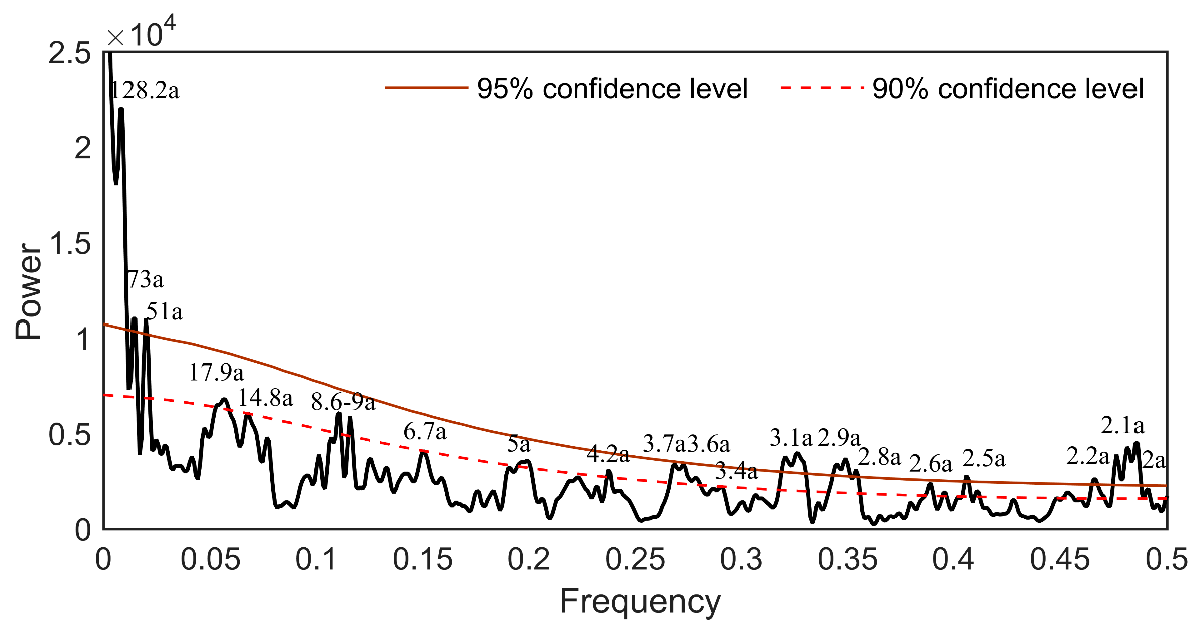

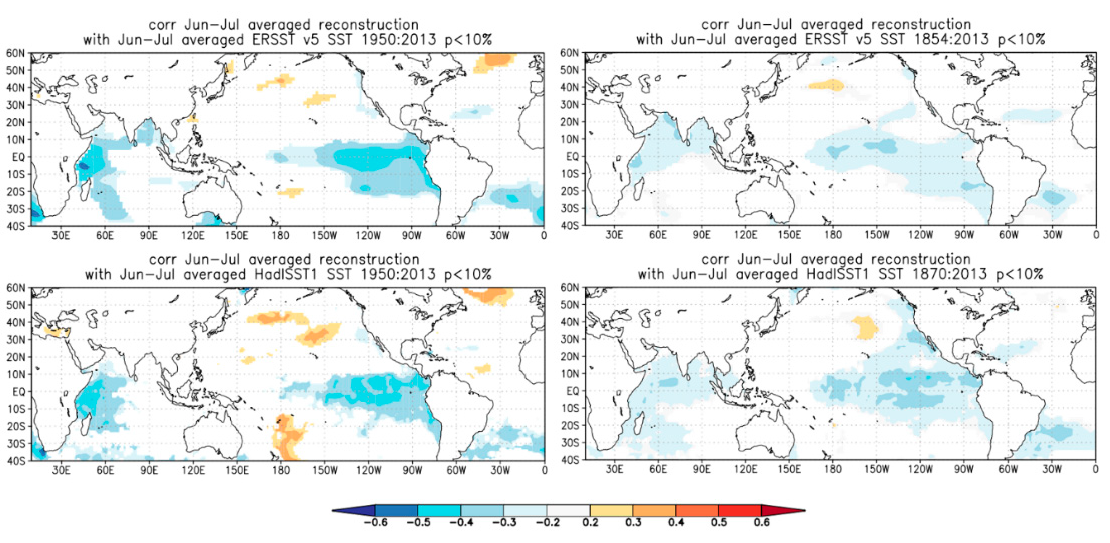
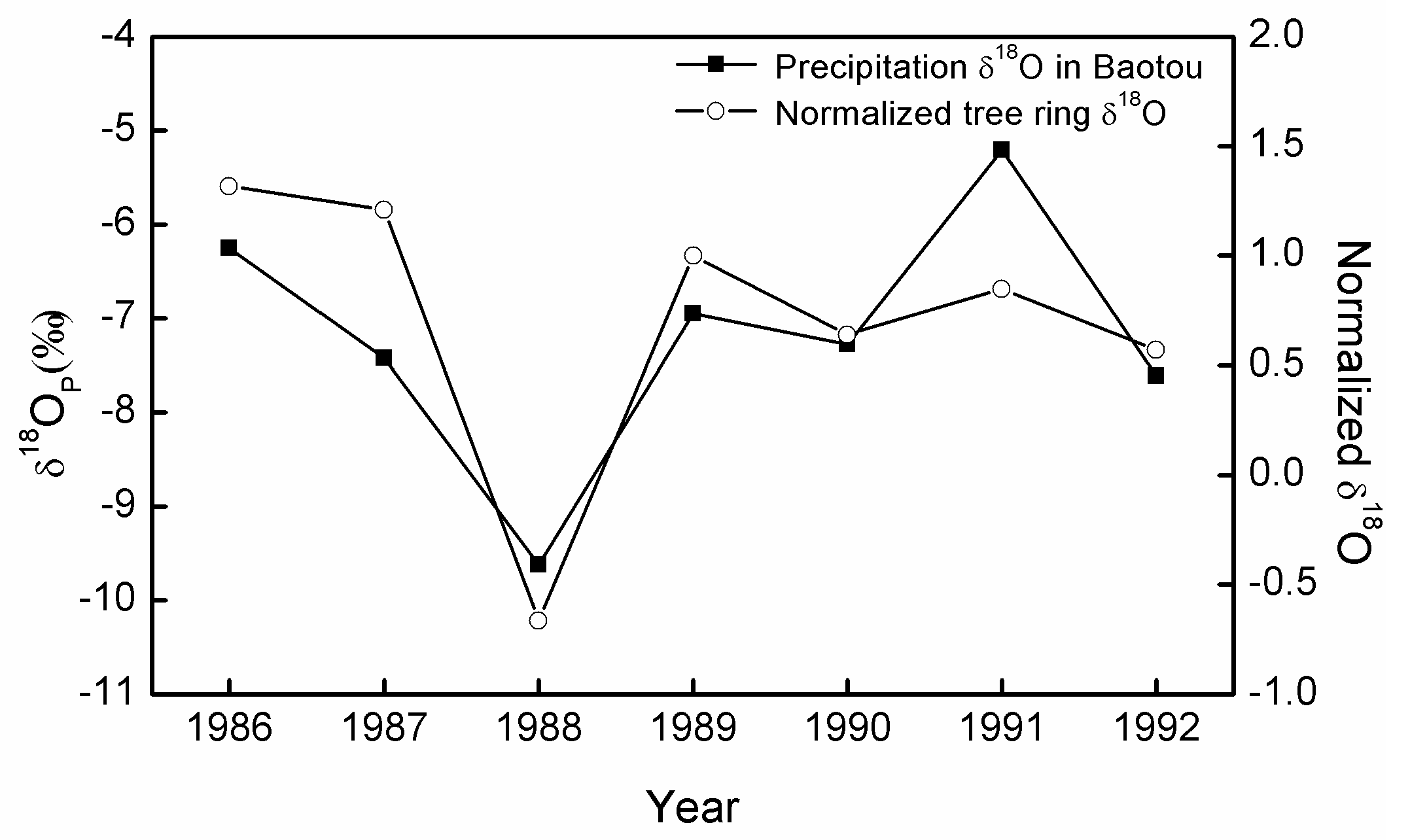

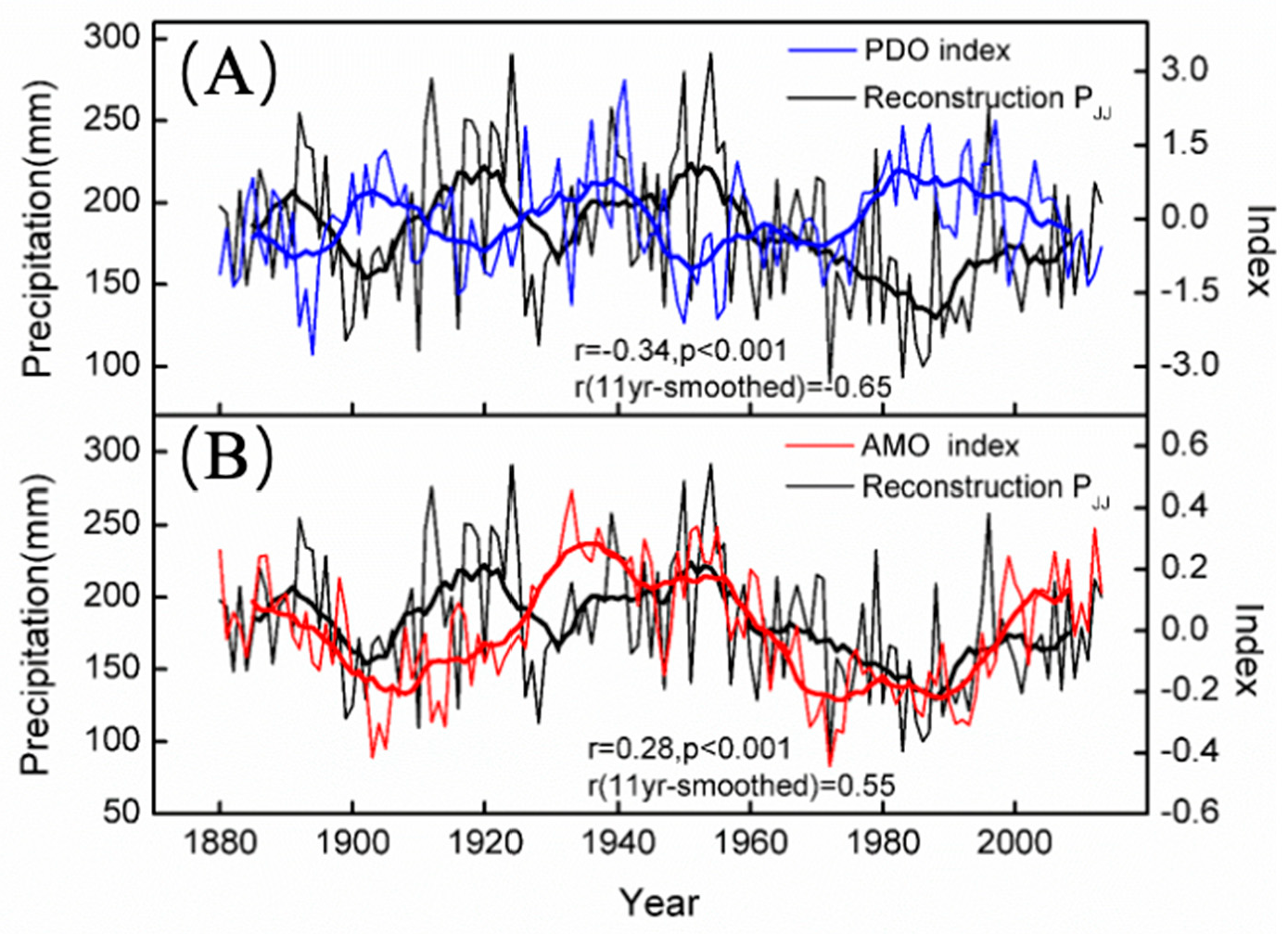
| ENSO Indices | Data Set | r (Whole Period) | r (1950–2013 AD) |
|---|---|---|---|
| NIÑO4 | ERSST(1854–) | −0.31/160, 0.001 | −0.29/64, 0.05 |
| HadISST(1870–) | −0.32/144, 0.001 | −0.28/64, 0.05 | |
| NIÑO3.4 | ERSST(1854–) | −0.29/1600, 0.001 | −0.40/64, 0.001 |
| HadISST(1870–) | −0.33/144, 0.001 | −0.39/64, 0.001 | |
| NIÑO3 | ERSST(1854–) | −0.28/160, 0.001 | −0.45/64, 0.001 |
| HadISST(1870–) | −0.31/144, 0.001 | −0.44/64, 0.001 | |
| NIÑO1 + 2 | ERSST(1854–) | −0.23/160, 0.01 | −0.43/64, 0.001 |
| HadISST(1870–) | −0.22/144, 0.01 | −0.36/64, 0.005 | |
| MEI | ESRL/PSD(1950–) | −0.50/64, 0.001 | / |
| SOI | Jones(1866–) | 0.19/148, 0.05 | 0.38/64, 0.005 |
Publisher’s Note: MDPI stays neutral with regard to jurisdictional claims in published maps and institutional affiliations. |
© 2022 by the authors. Licensee MDPI, Basel, Switzerland. This article is an open access article distributed under the terms and conditions of the Creative Commons Attribution (CC BY) license (https://creativecommons.org/licenses/by/4.0/).
Share and Cite
Liu, Y.; Shi, W.; Li, Q.; Liu, W.; Cai, Q. A 230-Year Summer Precipitation Variations Recorded by Tree-Ring δ18O in Heng Mountains, North China. Forests 2022, 13, 1654. https://doi.org/10.3390/f13101654
Liu Y, Shi W, Li Q, Liu W, Cai Q. A 230-Year Summer Precipitation Variations Recorded by Tree-Ring δ18O in Heng Mountains, North China. Forests. 2022; 13(10):1654. https://doi.org/10.3390/f13101654
Chicago/Turabian StyleLiu, Yu, Wenxin Shi, Qiang Li, Wentai Liu, and Qiufang Cai. 2022. "A 230-Year Summer Precipitation Variations Recorded by Tree-Ring δ18O in Heng Mountains, North China" Forests 13, no. 10: 1654. https://doi.org/10.3390/f13101654
APA StyleLiu, Y., Shi, W., Li, Q., Liu, W., & Cai, Q. (2022). A 230-Year Summer Precipitation Variations Recorded by Tree-Ring δ18O in Heng Mountains, North China. Forests, 13(10), 1654. https://doi.org/10.3390/f13101654








